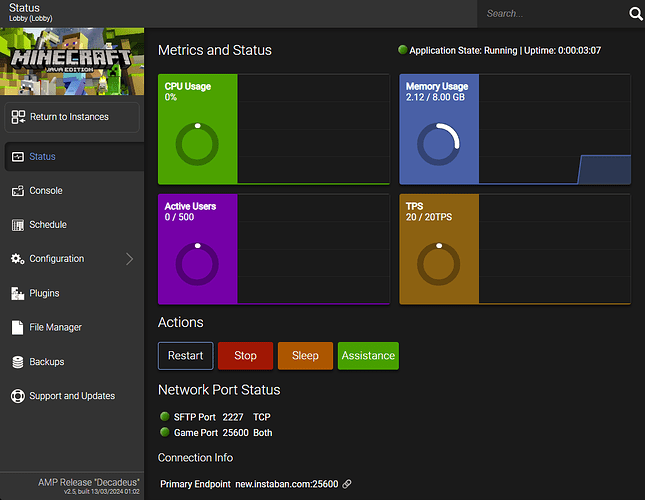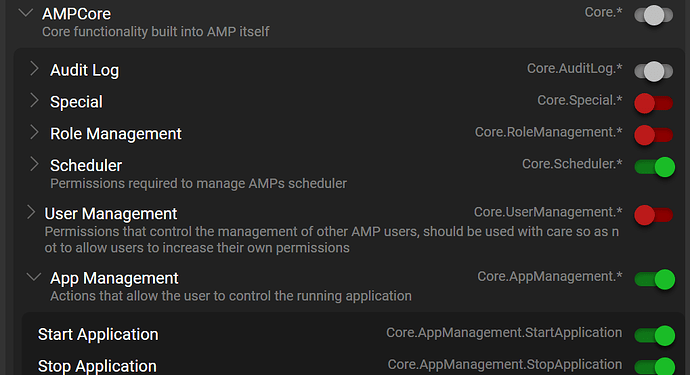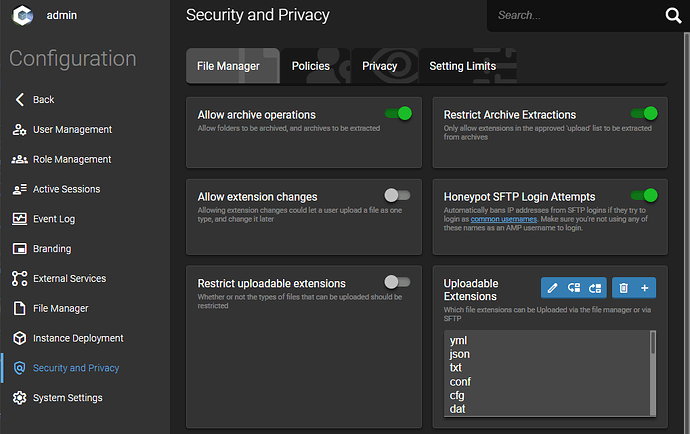About AMP 2.5 ‘Callisto’
AMP 2.5 is a major update with a significant number of changes and new features that affect almost every major component within AMP, as well as many quality of life improvements that have been requested by the community, along with a great many quashed bugs that affected usability.
For many of you (especially those of you who joined us during the Palworld peak) this may be your first significant update for AMP. If that is the case I’d recommend taking a moment to check out the documentation on updating AMP. It will be necessary to update the Instance Manager on both Windows and Linux for AMP to function properly with this update.
We’d also strongly recommend that everyone read these release notes in full, especially if you are relatively new to AMP and this is your first major update with a codename change.
Things to know before updating
AMP 2.5 has no backwards or forwards-compatibility with previous 2.4.x series updates. So it will be necessary to upgrade your entire AMP installation to create new instances or use instances running AMP 2.5.
User Interface Changes
ADS Instance List Metrics
The instance list is now far more useful. As well as showing metrics front-and-centre to let you see CPU or memory usage at a glance, it also lets you see the state of the application within the instance, and guides you appropriately if further action needs to be taken.
Metrics reporting is also much faster than previous, giving you live updates in ADS for status changes and frequent updates of resource usage.
Updated status page and instance management
The side menu has been tweaked to make it obvious that returning to the top level is a separate action, and the application image is shown to make it clearer what you’re working with.
The application uptime is now recorded and displayed both in the status page and in the console so you can see how long the application has been running. Additionally, the network information now shows more useful connection information, to make it easier to see exactly where you’re supposed to connect to join the game server.
New Features
Smart Backup Exclusions
For applications based on the Generic module (which is most of them these days) - the first time the application is updated, AMP will build a backup exclusion file that contains all of the files that were downloaded in that first update. This means that only files added after that point are backed up.
Smart Exclusions are disabled by default (the list is always built but ignored out of the box) - and can be turned on in the settings. Take a moment to review the backups after enabling this feature for the first time to make sure it includes everything you expect it to.
Configuration Importing
Again for applications based on the Generic module - AMP can now import configuration files for a wide variety of formats if the configuration layout allows for it. This means you can hand-edit your configuration files or load in existing files produced outside of AMP and read them into AMP so that your changes persist. Right now the configuration files you import must have the exact same as the original to be read in.
To use this feature, simply right click your configuration file in the file manager and select “Import Configuration”. If you do not see such a button in the menu then importing is not available for the application you’re using at this time. This feature has to be enabled on a per-application basis so it’ll take a while before you start seeing this roll out.
Swap control for Docker instances
It’s now possible to separately control the amount of swap space individual instances have access to in order to give you more control and flexibility over instance resource usage. Bare in mind that when applications reach their combined swap and memory limit, they will simply fail.
Recovery Mode on Windows Desktops
Previously a Linux-only feature, recovery mode means that you won’t be left with an unhelpful message if AMP fails to load or is otherwise unreachable. On Windows this applies when you open the “Instance Manager” GUI app and it automatically opens a browser for you.
Additional Scheduler Variables
There are now additional variables that can be included in Scheduled Tasks that don’t come from the trigger itself. See the list of new variables.
Template Values for Generic Executable
Authors of Generic Module templates now have more flexibility to allow the application being started along with other variables to be controlled based on the value of other settings.
Significant Changes
Faster ADS Loading
ADS used to load a very large amount of data (several megabytes in fact) every time you opened the page, which slowed things down as the browser processed it. Now, ADS simply loads a summary of the data so only what’s actually shown to the user is fetched. This significantly improves load times and responsiveness when first opening up AMP.
RCON Improvements
AMPs RCON implementation has been rewritten to make it more durable and reliable. This will address issues in a number of games that could cause the console in AMP to become unresponsive and prevented AMP from tracking games in certain situations.
The design of the various RCON clients internally also follows a more uniform and consistent design to make the feature more maintainable going forward.
User and Role management
By default, non-admin users can only see users and roles that they themselves created. The ability to see other users/roles is hidden behind a separate permission.
Instance Start-up and Shutdown on Windows
AMP now uses a cleaner mechanism to handle soft shutdowns on Windows, which means fewer instances of instances and their applications being forcefully killed.
The instance manager also uses a different mechanism to start instances on Windows entirely. This solves the long-standing issue of having to shut down every single instance in order to update ADS, and general issues where AMP could end up in a stalled state as a result of restarting ADS. The frustrations that could soft-lock AMP until a full reboot have been resolved with this change. Updates on Windows are significantly improved moving forward with this change.
Use of per-instance HMAC signing keys for metrics
Previously, making sure that metrics were valid took the form of using firewall rules to only accept metrics from the appropriate places, but this was burdensome and time consuming to set up.
AMP now assigns a HMAC signing key for each instance, which it uses to sign metrics data that it’s reporting to the controller. This is fully transparent and has been ensured to work with existing instances as well as brand new ones.
Expanded support for CPx2
The emulation layer used by AMP to run x86 and x86_64 applications on ARM64/aarch64 platforms can now be used on Debian systems in addition to Ubuntu.
Bug Fixes
- Fixed an erroneous “AMP tools are out of date” message if the tools version couldn’t be determined.
- Fixed issues resolving the external IP. No longer returns
nullif this fails. - Fixed a layout bug that caused the viewport to be wider than it should be on mobile if the side-menu in ADS was hidden (which was overflowing to the right side).
- Typographical and minor layout fixes throughout.
- Fixed a bug where ADS callbacks to billing systems (WHMCS, etc) could cause socket exhaustion over time.
- Fixed a bug where ADS would crash if an invalid hostname was specified for a remote target.
- Fixed branding information not being used for ticket creation. Enterprise users shouldn’t be shuttled through the support UI, only Retail users.
- Fixed a bug where the generic module might try to kill an already terminated process.
- Fixed configuration refreshes not working as expected. This is now handled in a single step when updating instances and is managed by the backend.
Minor Changes
- Added a Minimum Heap Size (XMS) setting to the Minecraft module.
- Update and Start is now the default behaviour when creating an instance.
- File sizes are now reported using SI units (MiB, GiB, etc)
- Added an option to show SteamCMD download speeds in bits (mbits, gbits, etc)
- Gravatar images are now lazy loaded to improve load times.
- The settings for Java arguments in the Minecraft module use a larger text area field.
- Removed use of
example.comvalues due to it causing 404 errors on load. - The honorific mention of Stephen Hawking has been removed.
- Added a configurable session time limit. Previously this was hard coded to 5 minutes of inactivity.
- Updated error reporter to expand the list of reasons not to submit an error report due to trivial or user-error issues.
- The licence key lost check now accommodates different key lengths as some users were entering their keys without the dashes.
- Changed the kill signal on Linux as some Minecraft plugins were erroneously sending SIGUSR1 signals.
- Added the ability for
ampinstmgrto use the Development branch, along with theQuickstartcommand to help with testing/using dev builds.










